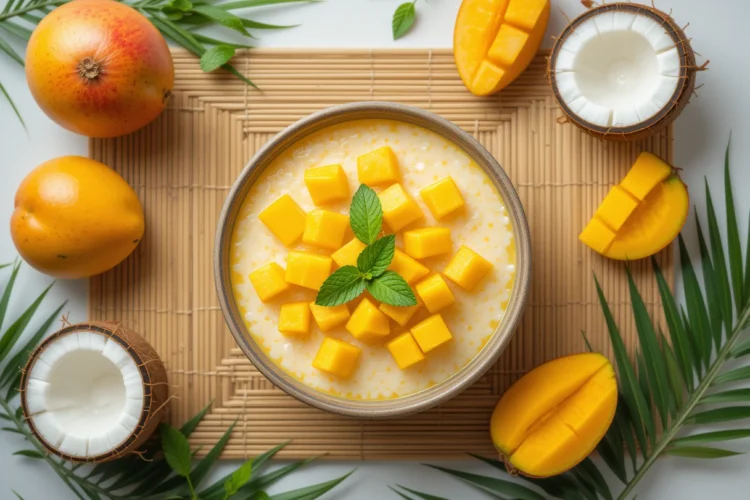There’s nothing quite like the cool, creamy comfort of a perfectly made mango sago dessert on a hot day! This beloved treat has captured hearts across Asia and the Philippines with its amazing combination of sweet, ripe mangoes, bouncy tapioca pearls, and rich coconut cream. Whether you’ve tried it at your favorite Filipino restaurant or discovered it at an Asian dessert shop, this refreshing dessert always leaves you wanting more.
Today, I’m sharing a reliable, beginner-friendly mango sago recipe that brings all those amazing flavors right to your kitchen. No special equipment needed – just simple ingredients and easy techniques that anyone can master. This recipe has been tested several times at home and is based on the traditional mango sago recipe Philippines style, with clear steps that ensure perfect results every time.
Get ready to create a dessert that’s not only delicious but also incredibly satisfying to make. Your family and friends will be amazed when you serve up this restaurant-quality treat that’s actually simple to prepare at home!
What Is Mango Sago Recipe?

Mango sago is a popular Asian dessert that combines sweet, juicy mangoes with small tapioca pearls (called sago) in a creamy coconut milk base. The dessert originated in Hong Kong but has become incredibly popular throughout Southeast Asia, with each region adding its own special touches and flavors.
The magic of this dessert lies in its wonderful texture contrast – you get the smooth creaminess of the coconut milk, the burst of fresh mango flavor, and the fun, bouncy texture of the sago pearls. It’s like having a party in your mouth with every spoonful!
In the Philippines, mango sago has become a staple at family gatherings, fiestas, and hot summer days. Filipino families often serve it as a refreshing ending to heavy meals or as a special treat for celebrations. The Filipino version tends to be a bit richer and sweeter than other variations, often incorporating more coconut flavor and sometimes adding evaporated milk for extra creaminess.
The classic mango pomelo sago recipe, popular in Cantonese cuisine, includes segments of pomelo fruit for added texture and a slight tartness that balances the sweetness. Both versions are absolutely delicious, and you can easily customize this basic recipe to match your preferences or add your favorite tropical fruits.
Ingredients For Mango Sago Recipe

Here’s everything you need to create this amazing mango sago filipino recipe:
Essential Ingredients:
• ½ cup mini tapioca pearls (sago) – Look for the small, white pearls in Asian grocery stores
• 3 ripe mangoes – Ataulfo or “champagne” mangoes work best for their creamy texture and sweet flavor
• 1 (13.5 oz) can full-fat coconut milk – The rich kind gives the best creamy texture
• ½ cup sweetened condensed milk – Start with this amount and adjust to taste
Optional Extras for Customization:• ½ teaspoon vanilla extract – Optional but adds nice depth of flavor
• 1 cup pomelo segments – For the traditional mango pomelo sago variation
• ¼–½ cup evaporated milk or fresh milk – To thin the mixture if needed
• 1–2 tablespoons sugar – Only if your mangoes aren’t sweet enough
• Ice cubes for serving – Essential for that refreshing experience
• Pinch of salt – Helps balance the sweetness perfectly
Tools You’ll Need: Medium saucepan, fine mesh strainer, bowl for ice bath, blender or food processor, large mixing bowl, measuring cups and spoons.
Time & Yield: Prep: 15 minutes | Cook: 15–20 minutes | Chill: 2–3 hours | Total: 2.5–3.5 hours | Serves 6
Step-by-Step Instructions For Mango Sago Recipe
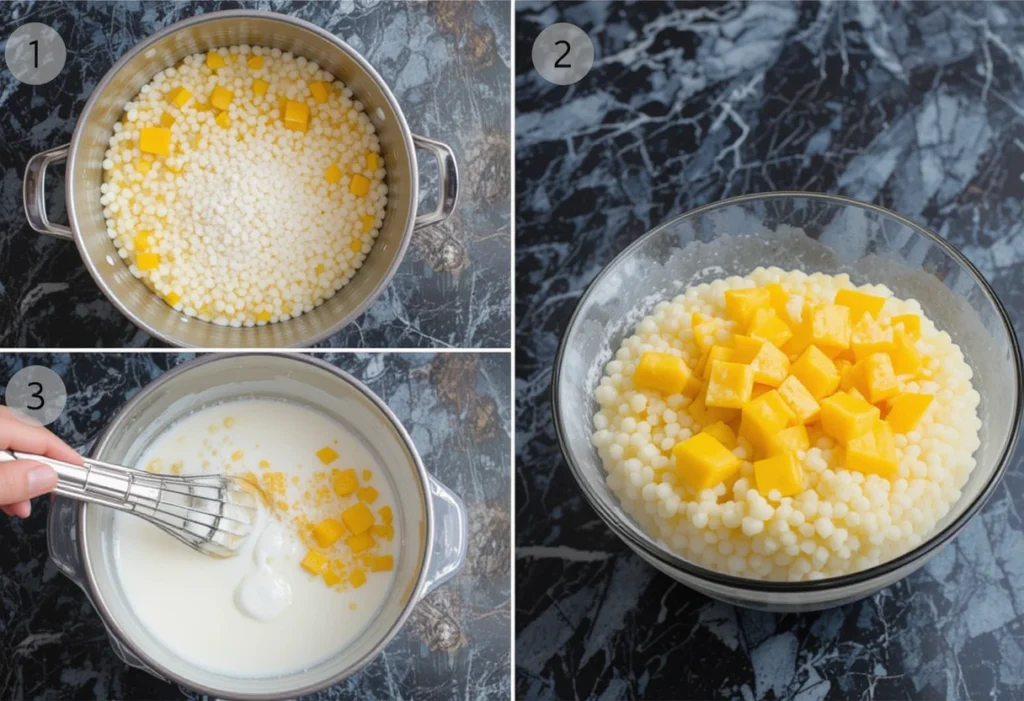
Step 1: Rinse the Sago Start by rinsing your mini tapioca pearls under cold running water until the water runs clear. This removes any excess starch that could make them stick together during cooking.
Step 2:Boil the Water Bring 6–8 cups of water to a rolling boil in your medium saucepan. Use plenty of water – this is crucial to prevent the sago from sticking together and ensures even cooking.
Step 3: Cook the Sago Add the rinsed sago to the boiling water and give it a good stir immediately. Let it simmer for 12–15 minutes, stirring occasionally. The pearls are ready when they’re almost completely translucent with just a tiny white dot in the center.
Step 4: Rest Off Heat Turn off the heat, cover the pot, and let the sago sit for 5–10 minutes. This final resting time allows them to become fully translucent and perfectly tender.
Step 5: Rinse and Chill the Sago Drain the cooked sago and rinse thoroughly with cold water. Transfer them to a bowl of cold water or ice bath to stop the cooking process completely. This keeps them bouncy rather than mushy. Set aside while you prepare the other components.
Step 6: Prepare the Mangoes Peel all three mangoes and remove the pits. Dice two mangoes into small, bite-sized cubes – these will add texture to your dessert. Take the remaining mango and blend it until completely smooth. This puree will give your recipe for mango sago that beautiful golden color and intense mango flavor.
Step 7: Make the Creamy Base In a large mixing bowl, whisk together the coconut milk, sweetened condensed milk, vanilla extract, and a tiny pinch of salt. Taste the mixture and adjust the sweetness by adding more condensed milk if needed. The base should be sweet but not overpowering.
Step 8: Combine Everything Drain your sago pearls very well and add them to the creamy base. Stir in the mango puree until everything is evenly distributed. Gently fold in most of the diced mango, saving some pieces for topping.
Step 9: Chill and Develop Flavors Cover the bowl and refrigerate for 2–3 hours. This chilling time is important because it allows the sago pearls to absorb the flavors and helps the dessert thicken to the perfect consistency.
Step 10: Serve and Enjoy Spoon the chilled mango sago into individual serving cups or bowls. Top with the remaining diced mango pieces and pomelo segments if using. Serve immediately while cold for the most refreshing experience.
This traditional mango sago filipino recipe creates the perfect balance of textures and flavors that will transport you straight to a tropical paradise!
Pro Tips For Mango Sago Recipe

Water Ratio Matters: Always cook your sago in plenty of water – at least 6 times the volume of the pearls. Stir vigorously during the first minute to prevent clumping and ensure even cooking throughout.
Check for Perfect Doneness: Your tapioca pearls should be completely translucent when properly cooked. If you still see white cores, let them rest off the heat a bit longer. Undercooked pearls will be tough and unpleasant to eat.
Stop the Cooking Process: Always rinse your cooked sago in cold water and keep them in an ice bath until ready to use. This prevents overcooking and maintains that perfect bouncy texture that makes this dessert so special.
Choose Ripe Mangoes for Best Results: The quality of your mangoes makes or breaks this dessert. Look for Ataulfo or “champagne” mangoes that are fragrant, give slightly to gentle pressure, and have vibrant color. Avoid mangoes that are too firm or overly soft.
Balance the Sweetness Carefully: Start with less sweetened condensed milk than you think you need. You can always add more, but it’s impossible to remove sweetness once it’s added. Taste as you go and adjust gradually.
Control the Thickness: If your mango sago becomes too thick after chilling, simply stir in a splash of evaporated milk, regular milk, or even coconut milk to reach your desired consistency.
Make-Ahead Smart Strategy: For the best texture, keep the cooked sago pearls and creamy mango base separate if preparing more than 24 hours ahead. Combine them just before serving to maintain the pearls’ perfect texture.
Variations For Mango Sago Recipe

Mango Pomelo Sago (Cantonese-Inspired) Transform this into the classic mango pomelo sago recipe by folding in 1 cup of fresh pomelo segments along with the diced mango. The pomelo adds a lovely tartness that balances the sweetness perfectly. You might want to add a bit more mango puree to maintain that tropical flavor balance. This pomelo mango sago recipe is incredibly popular in Hong Kong-style dessert shops.
Filipino Party Style Make your mango sago filipino recipe even more festive by adding ¼–½ cup of evaporated milk for a lighter, milkier flavor profile that’s perfect for large gatherings. Serve in small, clear dessert cups to show off the beautiful layers and colors.
Vegan and Dairy-Free Version Create a plant-based version by using only coconut milk and coconut cream for richness. Replace the sweetened condensed milk with maple syrup, agave nectar, or your preferred plant-based sweetener. The coconut provides natural creaminess without any dairy.
Light and Lower Sugar Reduce the sweetened condensed milk by half and replace part of the coconut milk with chilled low-fat milk. Add extra fresh mango pieces for natural sweetness and fiber. This version is still delicious but significantly lighter.
Drinkable Mango Sago Turn your dessert into a refreshing beverage by adding extra milk and ice cubes, then blend briefly for a smoothie-style treat. Perfect for hot summer days when you want something cool and satisfying.
Creative Toppings and Mix-ins Enhance your mango pomelo sago recipes with fun additions like nata de coco, mango jelly cubes, toasted coconut flakes, soaked chia seeds, or fresh mint leaves for extra flavor and visual appeal.
Why Filipinos Love Mango Sago Recipe

In Filipino culture, mango sago holds a special place as the perfect dessert for celebrations and hot weather relief. The Philippines is blessed with some of the world’s best mangoes, particularly during mango season from March to June, when families gather to enjoy the abundance of this beloved fruit.
This mango sago recipe philippines style has become synonymous with fiestas, family reunions, and Sunday gatherings. Filipino families often prepare large batches to share, making it a dessert that brings people together. The combination of coconut milk and sweet mangoes represents the tropical abundance of the islands, while the fun texture of sago pearls makes it appealing to both children and adults.
The dessert also reflects Filipino resourcefulness and creativity in the kitchen, taking simple, affordable ingredients and transforming them into something special and memorable that can feed a crowd without breaking the budget.
Storage and Make-Ahead Tips for the Mango Sago Recipe

Store your finished mango sago covered in the refrigerator for 2–3 days maximum. The texture is best within the first day or two, as the sago pearls can become softer over time. This dessert doesn’t freeze well due to the coconut milk and fresh fruit, so it’s best enjoyed fresh.
For make-ahead preparation, keep cooked sago pearls in cold water in the refrigerator for up to 24 hours before combining with other ingredients. Drain them well before mixing to prevent watering down your dessert. The mango puree and creamy base can also be prepared separately and combined just before serving for optimal texture and freshness.
Nutrition Snapshot for the Mango Sago Recipe
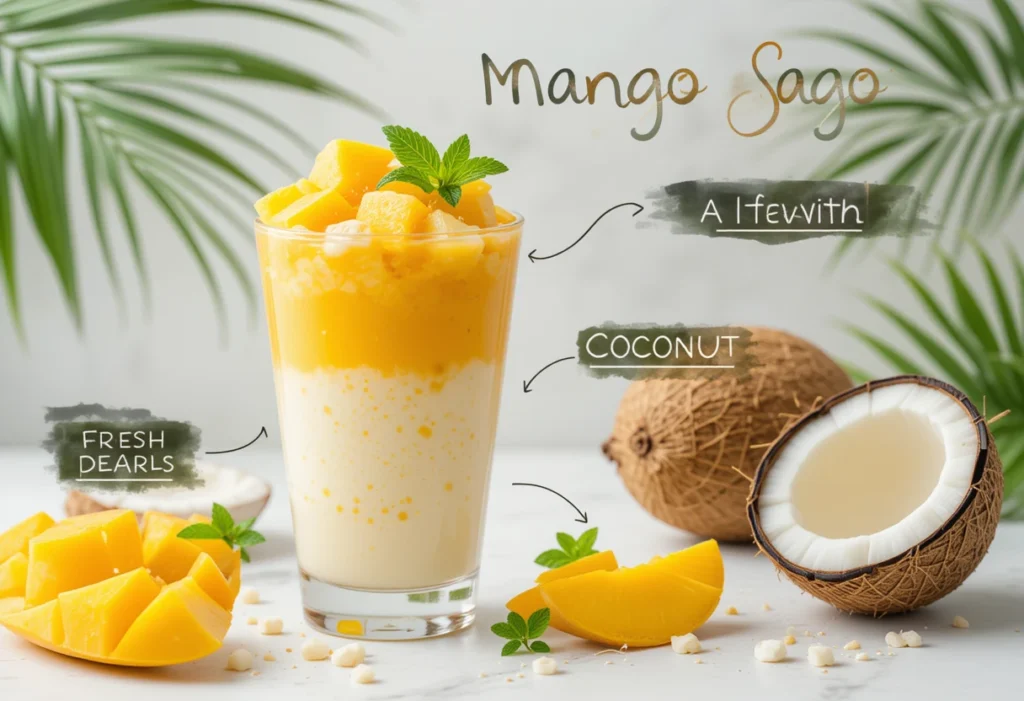
Each serving of this mango sago dessert recipe contains approximately 280-320 calories, depending on the amount of condensed milk used. The mangoes provide excellent vitamin C, vitamin A, and dietary fiber, while the coconut milk contributes healthy fats and natural energy. The tapioca pearls add carbohydrates for quick energy.
While this is definitely a treat to enjoy in moderation, the fresh fruit content makes it a more nutritious option than many processed desserts. The vitamin C content supports immune function, while the natural fruit sugars provide sustained energy.
Frequently Asked Questions About Mango Sago Recipe
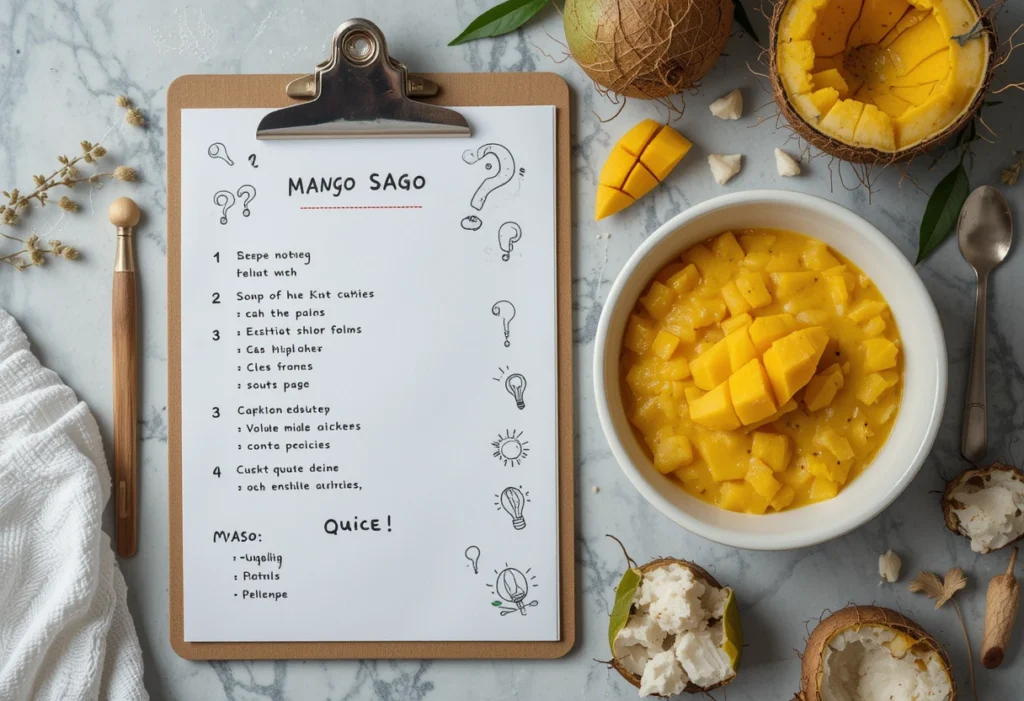
Is mango sago Filipino or Chinese?
Mango sago originated in Hong Kong but has been enthusiastically adopted and adapted throughout Southeast Asia, including the Philippines. Each culture has added its own twist to make it uniquely their own.
What’s the difference between the mango sago recipe and the mango pomelo sago?
The classic mango pomelo sago recipe includes segments of pomelo fruit, which adds a slightly tart flavor and interesting texture contrast. Regular mango sago focuses purely on mango flavor with the creamy coconut base.
Can I use canned mango instead of fresh?
Fresh mango gives the best flavor and texture, but you can use canned mango in syrup if needed. Drain the syrup and reduce the amount of sweetened condensed milk accordingly to avoid making the dessert too sweet.
Why are my sago pearls chewy or mushy?
Chewy pearls usually mean they’re undercooked – they need more simmering time or resting time off heat. Mushy pearls are overcooked – make sure to stop the cooking process with cold water immediately after they’re translucent.
How do I make this vegan or lower in sugar?
Replace condensed milk with coconut cream and maple syrup for vegan version. For lower sugar, use less condensed milk and rely more on the natural sweetness of ripe mangoes.
Conclusion
This easy mango sago recipe brings the beloved flavors of Filipino and Asian dessert shops right to your home kitchen. With its perfect balance of creamy coconut, sweet tropical mango, and fun tapioca pearls, it’s a dessert that never fails to impress and refresh.
The beauty of this mango sago dessert recipe lies in its simplicity and versatility. Whether you stick to the classic version or experiment with the variations, you’re creating something special that celebrates the wonderful flavors of tropical cuisine.
Ready to bring this taste of the tropics to your table? Gather your ingredients and give this recipe a try – your taste buds will thank you for this delicious adventure!
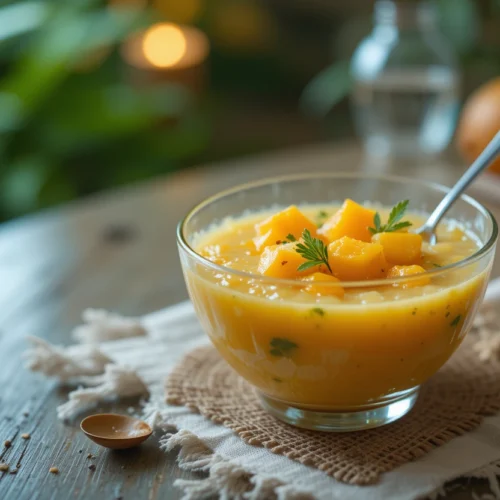
Mango Sago Recipe (Filipino-Style) – Easy & Creamy
Ingredients
Essential Ingredients
- ½ cup mini tapioca pearls sago
- 3 ripe mangoes Ataulfo or “champagne” mangoes preferred
- 1 13.5 oz can full-fat coconut milk
- ½ cup sweetened condensed milk adjust to taste
Optional
- ½ teaspoon vanilla extract optional
- 1 cup pomelo segments for mango pomelo sago variation
- ¼ –½ cup evaporated milk or fresh milk to thin if needed
- 1 –2 tablespoons sugar if mangoes aren’t sweet enough
- Ice cubes for extra chill
- Pinch of salt balances sweetness
Instructions
- Cook Sago – Boil sago pearls until translucent, then rinse and drain.
- Prepare Mango – Peel and dice mangoes; blend half into puree, keep half as cubes.
- Mix Base – In a bowl, combine coconut milk, condensed milk, and mango puree.
- Assemble – Add cooked sago and mango cubes, mix well.
- Chill & Serve – Refrigerate 1–2 hours, then serve cold.
